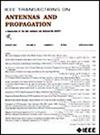A Vertex Function--Based Radial--Angular Quadrature for the Numerical Evaluation of Surface Test Integrals in the Method of Moments
IF 4.6
1区 计算机科学
Q1 ENGINEERING, ELECTRICAL & ELECTRONIC
引用次数: 0
Abstract
A novel integration scheme is proposed for the accurate numerical evaluation of test (reaction) integrals needed for solving complex direct or inverse electromagnetic problems using surface integral equation (SIE) formulations and the method of moments. Significant effort has already been devoted to improving the numerical evaluation of source integrals yielding potentials (or their derivatives), especially for triangular elements. However, numerical techniques for accurately evaluating the subsequent test integrals have been largely neglected, with simple numerical integration schemes being used that either ignore or are developed with incomplete knowledge of the detailed behavior of potentials (or their derivatives) near edges and vertices. Consequently, simple numerical quadrature schemes are found to be either of limited accuracy or slowly convergent with respect to increasing the sampling for self, edge- or vertex-adjacent source, and test triangle pairs. Here, we describe a simple model derived from static potential integrals that properly describes and bounds the potentials and their derivatives near vertices. From it, we are able to construct appropriate, separable radial-angular quadrature schemes that are both exponentially convergent and applicable to all potential forms of interest arising from both EFIE and MFIE operators. Numerical results are presented that demonstrate the wide-ranging applicability and improved convergence rates of the proposed scheme, and these are compared to some previously reported testing schemes. The method’s sensitivity to test triangle shape and the ratio choice of angular-to-radial sampling rates is also briefly explored.基于顶点函数的径向角正交矩法曲面测试积分数值计算
提出了一种新的积分格式,利用曲面积分方程和矩量法,对求解复杂的正反电磁问题所需的试验(反应)积分进行精确的数值计算。在改进源积分产生势(或其导数)的数值计算,特别是三角元的数值计算方面,已经作出了重大的努力。然而,用于准确评估后续测试积分的数值技术在很大程度上被忽视了,使用的简单数值积分方案要么忽略了,要么是在不完全了解边缘和顶点附近势(或其导数)的详细行为的情况下开发的。因此,简单的数值正交方案要么是有限的精度,要么是缓慢收敛的关于增加采样的自,边或顶点相邻的源,和测试三角形对。在这里,我们描述了一个简单的模型,从静态势积分,适当地描述和边界势及其导数在顶点附近。由此,我们能够构造适当的、可分离的径向-角正交方案,这些方案既具有指数收敛性,又适用于由EFIE和MFIE算子引起的所有潜在形式的兴趣。数值结果表明,该方法具有广泛的适用性和提高的收敛速度,并与先前报道的一些测试方案进行了比较。并简要探讨了该方法对测试三角形形状的敏感性和角径向采样率的比值选择。
本文章由计算机程序翻译,如有差异,请以英文原文为准。
求助全文
约1分钟内获得全文
求助全文
来源期刊
CiteScore
10.40
自引率
28.10%
发文量
968
审稿时长
4.7 months
期刊介绍:
IEEE Transactions on Antennas and Propagation includes theoretical and experimental advances in antennas, including design and development, and in the propagation of electromagnetic waves, including scattering, diffraction, and interaction with continuous media; and applications pertaining to antennas and propagation, such as remote sensing, applied optics, and millimeter and submillimeter wave techniques

 求助内容:
求助内容: 应助结果提醒方式:
应助结果提醒方式:


